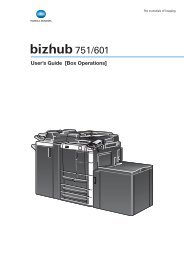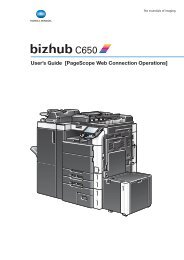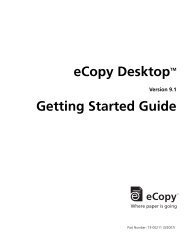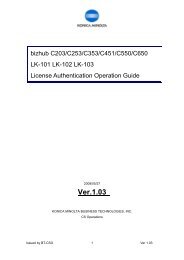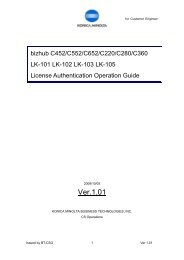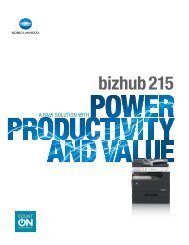Create successful ePaper yourself
Turn your PDF publications into a flip-book with our unique Google optimized e-Paper software.
Rev 1.0<br />
KONICA MINOLTA<br />
<strong>GP</strong>-502<br />
OPERATION MANUAL<br />
February 2012
1. Safety<br />
2. Overview<br />
Table of Contents<br />
2.1 Features & Benefits of <strong>GP</strong>-502<br />
2.2 Ellipse Binding Elements<br />
2.3 User Interface & Feature Locations<br />
3. Installation<br />
4. Unit Operation - Bypass<br />
5. Unit Operation -Binding<br />
5.1 Getting To Know The <strong>GP</strong>-502<br />
5.2 Installing Elements<br />
6. Creating Bind Job<br />
6.1 Setting Front & Back Cover<br />
6.2 Enabling Bind Function<br />
6.3 Folding Book Over<br />
7. Media<br />
7.1 Bypass<br />
7.2 Binding<br />
8. Jam Clearance<br />
8.1 Bypass Path Jam Clearance<br />
8.2 Bind Path Jam Clearance<br />
8.3 Element Jam Clearance<br />
8.4 Book Jam Clearance<br />
8.5 Jam Due To Opening Front Door<br />
9. Language Selection<br />
10. Specification<br />
Rev 1.0cccccccccccccccccc ccccccccccccccccccccccccccccccccc 2<br />
cccccccc July 2012
1. Safety<br />
THE SAFETY OF YOU AND OTHERS IS VERY IMPORTANT TO<br />
GBC. IMPORTANT SAFETY MESSAGES AND INFORMATION<br />
ARE CONTAINED IN THIS MANUAL AS WELL AS ON THE<br />
MACHINE ITSELF. PLEASE MAKE SURE YOU CAREFULLY<br />
READ AND UNDERSTAND ALL OF THESE BEFORE<br />
OPERATING THE MACHINE.<br />
THE SAFETY ALERT SYMBOL PRECEDES EACH<br />
SAFETY MESSAGE IN THIS OPERATION<br />
INSTRUCTIONS MANUAL. THIS SYMBOL<br />
INDICATES A POTENTIAL PERSONAL SAFETY<br />
HAZARD THAT COULD HURT YOU OR OTHERS<br />
THE FOLLOWING PICTORIAL IS FOUND ON THE <strong>GP</strong>-502.<br />
This safety message means you could<br />
get an electrical shock because<br />
disconnecting power from this section<br />
does not cut off power from adjacent<br />
sections of the machine.<br />
This safety message means that you<br />
might get seriously hurt or killed if you<br />
open the product and expose yourself to<br />
hazardous voltage. NEVER remove the<br />
screwed on covers.<br />
ALWAYS refer service<br />
• Use the <strong>GP</strong>-502 only for its intended purpose of punching<br />
and binding books using paper and covers according to the<br />
indicated specifications.<br />
• Retain this Operation Instructions manual for future use.<br />
CAUTION: THE PRINTER ON/OFF SWITCH DOES<br />
NOT CUT OFF POWER FROM THE BINDER.<br />
CAUTION: THE PUNCH ON/OFF SWITCH DOES<br />
NOT CUT OFF POWER FROM THE BINDER.<br />
• The <strong>GP</strong>-502 must be connected to a supply voltage<br />
corresponding to the electrical rating of the machine<br />
operation instructions (also listed on the serial number label).<br />
• The grounding plug is a safety feature and will only fit into<br />
the proper grounding-type power outlet. If you are unable to<br />
insert the plug into an outlet, contact a qualified electrician to<br />
have a suitable outlet installed.<br />
• Do not alter the plug on the end of the cordset of the <strong>GP</strong>-502.<br />
It is provided for your safety.<br />
• Unplug the <strong>GP</strong>-502 before moving the machine or whenever<br />
the machine is not in use for an extended period of time.<br />
• Do not operate the <strong>GP</strong>-502 if the machine has a damaged<br />
power supply cord or plug. Do not operate the machine after<br />
any malfunction. Do not operate the machine in case of<br />
liquid spills, or if the machine has been damaged in any<br />
other way.<br />
• Do not overload electrical outlets.<br />
FCC NOTE<br />
(THE FOLLOWING NOTE ONLY APPLIES TO THE UNITS<br />
RATED 115V 60HZ.)<br />
This equipment has been tested and found to comply with the<br />
limits for a Class A digital device, pursuant to Part 15 of the FCC<br />
Rules. These limits are designed to provide reasonable protection<br />
against harmful interference when the equipment is operated in a<br />
commercial environment.<br />
This equipment generates, uses, and can radiate radio frequency<br />
energy and, if not installed and used in accordance with the<br />
Operation Manual, may cause harmful interference with radio<br />
communications.<br />
Operation of this equipment in a residential area is likely to cause<br />
harmful interference in which case the user will be required to<br />
correct the interference at his/her own expense.<br />
Safety messages<br />
CAUTION: CHANGES OR MODIFICATIONS NOT<br />
EXPRESSLY APPROVED BY GENERAL BINDING<br />
CORPORATION COULD VOID YOUR AUTHORITY TO<br />
OPERATE THE EQUIPMENT.<br />
Canada Class A Notice - Avis Canada, Classe A<br />
This Class A digital apparatus complies with Canadian ICES-3.<br />
Cet appareil numérique de la classe A est conforme à la norme<br />
NMB-003 du Canada.<br />
MAIN CORDSET SELECTION<br />
(THE FOLLOWING NOTE ONLY APPLIES ONLY TO THE UNITS<br />
RATED 230V 50HZ, AND LOCATED IN THE EUROPEAN<br />
UNION)<br />
CAUTION: WHEN CHOOSING A DETACHABLE LINE<br />
CORD FOR USE WITH YOUR <strong>GP</strong>-502,<br />
ALWAYS FOLLOW THE FOLLOWING PRECAUTIONS<br />
The cordset consists of three parts: the attachment plug, the cord<br />
and the appliance inlet. Each of these components must have<br />
European regulatory safety approvals.<br />
The following minimum electrical ratings for the specific cordset<br />
are published for safety purposes.<br />
DO NOT USE CORDSETS THAT DO NOT MEET THE<br />
FOLLOWING MINIMUM ELECTRICAL REQUIREMENTS.<br />
PLUG: 3 amperes, 250 volts, 50/60 Hz, Class 1, 3 conductor,<br />
European safety approved.<br />
CORD: Type H05VV-F3G0.75, Harmonized (< HAR>). The "< >"<br />
symbols indicate cord approved according to appropriate<br />
European standard (NOTE: "HAR" may be substituted for<br />
approval mark of European safety agency that approved the cord.<br />
An example would be "< VDE >").<br />
APPLIANCE CONNECTOR: 3 amperes, 250 volts, 50/60 Hz,<br />
European safety approved, Type IEC 320. The cordset shall not<br />
exceed 3 meters in length. A cordset with component electrical<br />
ratings<br />
Rev,1.0,,,,,,,,,,,,,,,,,,,,,,,,,,,,,,,,,,,,,,,,,,,,,,,,,,,,,,,,,,,,,,,,,,,,,,,,,,,,,,,, 3<br />
, ...............,,, July 2012
2. Overview<br />
2.1 FEATURES & BENEFITS OF THE <strong>GP</strong>-502<br />
The GBC <strong>GP</strong>-502 attaches directly to your high-speed <strong>Konica</strong> <strong>Minolta</strong> printer. Documents flow directly from<br />
the printer to the binding system without the bottleneck associated with traditional offline punching processes.<br />
The GBC <strong>GP</strong>-502 online binding system not only affords superior turnaround times, but also significantly<br />
reduces labor costs. Only one operator is required to print, punch and bind documents.<br />
The <strong>GP</strong>-502 is an automated binder system capable of binding small and large books by simply making a<br />
selection on the printers screen. The <strong>GP</strong>-502 reduces downtime by not requiring the Ellipse binding element<br />
to be changed when different size books are produced. By use of internal automation, all books whether large<br />
or small are all created with only one common Ellipse element.<br />
Some customer benefits noted for this system include:<br />
• Docks to the <strong>Konica</strong> <strong>Minolta</strong> printer to combine printing, punching, collating, and binding into one<br />
convenient step.<br />
• Increases throughput of finishing applications with a completely automated process.<br />
• Creates books that lie-flat and wrap around for easy note taking.<br />
• Operates seamlessly with no supply changeovers required for different size books.<br />
• Utilizes an attractive new element to bind all document sizes.<br />
• Compared to other styles of binding, the unique elliptical shape of the GBC <strong>GP</strong>-502 element creates a<br />
more stable document that takes up less space when shipping, stacking and storing.<br />
• Easily operable with limited user training.<br />
• Saves costs by bringing out-sourced jobs in-house.<br />
• Outputs printed, punched, bound and neatly stacked documents in the convenient document stacker.<br />
2.2 Ellipse Binding Elements<br />
The Ellipse binding element is available in four colors.<br />
•Black, Qty 200: .......... Type#: Ring Binder RB-101 Black<br />
•Clear, .Qty 200: ......... Type#: Ring Binder RB-101 Clear<br />
•White, Qty 200:.......... .Type#: Ring Binder RB-101 White<br />
•Navy Blue, Qty 200: . .Type#: Ring Binder RB-101 Navy Blue<br />
Rev1.0 ........... ..........................................111111111111111‘‘‘‘‘‘‘‘‘‘‘‘‘‘‘‘‘‘‘‘‘‘‘‘<br />
4<br />
‘‘July.2012
2.3 User Interface & Feature Locations<br />
PAPER PATH<br />
See Fig. 1 for an illustration of the <strong>GP</strong>-502 bind paper path.<br />
FEATURE LOCATIONS:<br />
A. <strong>GP</strong>-502 screen/display:<br />
Shows operational status of <strong>GP</strong>-502<br />
B. Paper Tray:<br />
Holds sheets until book is bound and dropped into book drawer.<br />
C. Element Feeder:<br />
Holds Ellipse binding element and feeds element for binding.<br />
D. Paper Punch:<br />
Paper is punched before being delivered to the paper tray.<br />
E. Book Chute:<br />
After the book is bound it is fed through the book chute.<br />
F. Vertical Paper Path:<br />
Sheets are fed along vertical paper path to paper punch.<br />
G. Bypass Path:<br />
Bypassed sheets are fed along this paper path.<br />
H. Front Door:<br />
I. Top Cover & Handle:<br />
J. Book Drawer:<br />
Completed books are stacked in the book drawer.<br />
K. Chip Tray:<br />
Contains punch chips/waste.<br />
Fig. 1<br />
Rev1.0 ........... ..........................................111111111111111‘‘‘‘‘‘‘‘‘‘‘‘‘‘‘‘‘‘‘‘‘‘‘‘ 5<br />
‘‘July 2012
3. Installation<br />
The <strong>GP</strong>-502 should only be installed by a Customer Engineer (CE). Please contact service representative for<br />
installation of this finisher with the host printer.<br />
1. Power Inlet:<br />
The power inlet is located on the rear of the <strong>GP</strong>-502. Attach the included power cord to the <strong>GP</strong>-502 at<br />
this location. Only use power that meets the voltage and frequency as listed on the rating label located<br />
on the <strong>GP</strong>-502.<br />
2. Power Switch:<br />
The power switch is located on the rear of the <strong>GP</strong>-502.<br />
4. Unit Operation - Bypass<br />
NOTE: Setting the power switch to the off position will not turn off all power within<br />
the <strong>GP</strong>-502. Power is passed through the <strong>GP</strong>-502 by and other finishers.<br />
Whenever binding is not selected for the <strong>GP</strong>-502 bypass will be enabled. For bypass operation no<br />
consideration needs to be made for media weight or size, all acceptable printer paper sizes and weights<br />
can be bypassed.<br />
Rev1.0 ........... ..........................................111111111111111‘‘‘‘‘‘‘‘‘‘‘‘‘‘‘‘‘‘‘‘‘‘‘‘ 6<br />
‘‘July.2012
5. Unit Operation - Binding<br />
5.1 GETTING TO KNOW THE <strong>GP</strong>-502<br />
1<br />
The <strong>GP</strong>-502 will temporarily stop in the process of<br />
creating a book if the main body's (printer) paper feed<br />
drawer runs out of paper; opening and closing the top cover<br />
when in this condition will cause the <strong>GP</strong>-502 to display a<br />
JAM. Because of this, the top cover should never be<br />
opened while the <strong>GP</strong>-502 is operating.<br />
To operate the <strong>GP</strong>-502 three areas of the machine require<br />
regular attention from the operator.<br />
1.Book Drawer:<br />
After the <strong>GP</strong>-502 completes the binding of a book it is<br />
dropped into the book drawer. The book drawer will<br />
hold up to 35 books before it declares to the printer that<br />
it is full. The number of books held in the drawer is<br />
dependent upon the size of the book created. Larger<br />
books will fill the drawer much sooner than small<br />
books.<br />
The book drawer should never be opened while the<br />
<strong>GP</strong>-502 is operating. Opening the book drawer while<br />
the <strong>GP</strong>-502 or printer is operating will result in a paper<br />
jam. After the printer and finishers within the system<br />
have stopped operating it is safe to open the book<br />
drawer.<br />
2<br />
The <strong>GP</strong>-502 will alert the operator when the book drawer<br />
requires emptying or when it is open. See the two illustrations to the right.<br />
3<br />
HIDING SPINE OF BINDING ELEMENT<br />
To improve the appearance of the bound<br />
book, flip the rear cover over after the book is<br />
bound. This will cause the spine of the bound<br />
book to be hidden between the rear cover and<br />
the last page of the book body.<br />
When removing the finished books from the<br />
book drawer, do not grasp the book by the<br />
binding loop. Grasping or holding the binding<br />
loop can cause the element loop shape to<br />
change.<br />
The <strong>GP</strong>-502 may temporarily stop during operation. Opening the book drawer of the <strong>GP</strong>-502 when in this<br />
state will cause a paper jam. Always wait to open the book drawer until the <strong>GP</strong>-502 operation has completely<br />
stopped.<br />
Rev1.0 ........... ..........................................111111111111111‘‘‘‘‘‘‘‘‘‘‘‘‘‘‘‘‘‘‘‘‘‘‘‘ 7<br />
‘‘July 2012
2. Punch Chip Tray:<br />
The punch waste tray contains the paper chips/waste that result<br />
from punching holes in the paper. The tray will hold a maximum<br />
of roughly 5,000 punches.<br />
Before emptying the chip tray, wait until the printer and finishers<br />
have finished operating, then open the front door and remove the<br />
chip tray.<br />
The <strong>GP</strong>-502 will alert the operator when the chip tray requires<br />
emptying or when it is missing. The two illustrations on the right<br />
show the images that the <strong>GP</strong>-502 screen will display when the<br />
chip tray needs attention.<br />
To empty the chip tray first open the front door, then remove the<br />
chip tray in a waste basket as shown in the illustration. Before<br />
replacing the chip tray in the <strong>GP</strong>-502, remove any spilled paper<br />
chips by using a vacuum cleaner. The emptied chip tray can now<br />
be inserted into the <strong>GP</strong>-502 and the front door closed.<br />
3. Element Feeder Drawer:<br />
Before operating the <strong>GP</strong>-502 binding elements<br />
must be installed into the element feeder drawer. For<br />
detailed instructions on this process see section 5.2.<br />
The <strong>GP</strong>-502 will alert the operator when the element<br />
feeder drawer is empty or when it is open. See the two<br />
illustrations below.<br />
Rev1.0 ........... ..........................................111111111111111‘‘‘‘‘‘‘‘‘‘‘‘‘‘‘‘‘‘‘‘‘‘‘‘ 8<br />
‘‘July.2012
5.2 INSTALLING ELEMENTS INTO THE <strong>GP</strong>-502<br />
1. Open the front door of the <strong>GP</strong>-502. Then locate the<br />
element drawer, which can be identified by the label<br />
shown below.<br />
Open the element drawer by squeezing the two blue<br />
handles together.<br />
2. Install the elements by aligning the locating hole on<br />
the elements with the rod on the element drawer.<br />
Install the elements after flipping the rear side of the<br />
elements to remove any dust that may be present.<br />
3. Press the elements firmly into place to secure the<br />
adhesive to the element drawer. Failure to perform this<br />
task could lead to element feeding trouble within the<br />
<strong>GP</strong>-502.<br />
4. A maximum of 115 elements can be installed into the<br />
element drawer. To install additional elements place<br />
them on top of the elements that are already in the<br />
drawer. Always press the elements firmly in the drawer<br />
to properly secure them. Do not overfill the element<br />
drawer; doing so will cause the elements to be<br />
damaged when the drawer is closed.<br />
Elements should be installed into the drawer not to<br />
exceed the Max label.<br />
Continued on next page<br />
Rev1.0 ........... ..........................................111111111111111‘‘‘‘‘‘‘‘‘‘‘‘‘‘‘‘‘‘‘‘‘‘‘‘ 9<br />
‘‘July 2012
5.2 INSTALLING ELEMENTS INTO THE <strong>GP</strong>-502<br />
5. When installing additional elements into the<br />
element drawer ensure that each set of<br />
elements is aligned with the previous set.<br />
Precise alignment is not required, yet severe<br />
misalignment should be corrected.<br />
The photo on the right shows an acceptable<br />
amount of misalignment within the element sets.<br />
6. Squeeze the handles of the element drawer<br />
together and then push the drawer into the <strong>GP</strong>-<br />
502. Always make sure to continue squeezing<br />
the handles of the element drawer until after the<br />
drawer is fully inserted into the machine. Failure<br />
to squeeze the handles while inserting the<br />
element drawer may cause element feeding<br />
errors.<br />
The illustrations below are shown on the <strong>GP</strong>-502 to aid in the installation of elements<br />
Rev1.0 ........... ..........................................111111111111111‘‘‘‘‘‘‘‘‘‘‘‘‘‘‘‘‘‘‘‘‘‘‘‘ 10<br />
‘‘July.2012
6. Creating Bind Job<br />
6.1 SETTING FRONT & BACK COVER<br />
The <strong>GP</strong>-502 requires that a front and back cover be used. Refer<br />
to the media section of this manual for a list of approved cover<br />
weights.<br />
Refer to the printers display, then perform the<br />
following:<br />
1. Check the <strong>GP</strong>-502 screen and ensure that is<br />
states ready. See Fig. 1<br />
2. Navigate to the (Copy) menu. Select<br />
(Application). See Fig. 2<br />
3. Select (Insert Sheet). See Fig. 3<br />
Fig. 3<br />
4. Select an approved cover type for<br />
both the front and back cover. See Fig. 4<br />
6.2 ENABLING BIND FUNCTION<br />
Refer to the media section of this manual for a list of<br />
approved paper weights for the book body.<br />
Refer to the printers display, then perform the following:<br />
1. Navigate to the (Copy) menu. Then select<br />
(Output Setting). See Fig. 4<br />
2. Select the (Ring Bind) function. See Fig. 5<br />
Fig. 4<br />
Fig. 1<br />
Fig. 4<br />
Fig. 5<br />
Fig. 2<br />
Rev1.0 ........... ..........................................111111111111111‘‘‘‘‘‘‘‘‘‘‘‘‘‘‘‘‘‘‘‘‘‘‘‘ 11<br />
‘‘July 2012
7. Media<br />
7.1 Bypass<br />
For bypass operation no consideration needs to be made for media weight or size, all acceptable printer paper<br />
sizes and weights can be bypassed.<br />
7.2 Binding<br />
When binding a book with the <strong>GP</strong>-502, be certain to only use the approved paper sizes and weights. Using the<br />
incorrect media weight or size will result in poor performance or no operation at all.<br />
Book Size:<br />
The <strong>GP</strong>-502 is limited to the size of book to which can bound. The number of sheets that can be bound in one<br />
book is dependent upon the weight and thickness of the media. See the below book size restriction based<br />
upon 75 gsm.<br />
Paper Size:<br />
Two <strong>GP</strong>-502 models exist, one for binding Letter paper (216x279mm) and another for binding A4 paper<br />
(210x297mm). Each <strong>GP</strong>-502 can only accept one paper size through the bind paper path (A4 or Letter<br />
respectively).<br />
Book Covers:<br />
Covers are required to ensure proper machine operation and book stacking. Not using covers can result in<br />
jams and damage to the books as they are ejected and stacked. See the below list of approved cover types.<br />
Book Body:<br />
The book body is referring to sheets that are not the out covers and are not inserted tabs. The acceptable<br />
media weight of the body of the book is given below.<br />
Tabs:<br />
Book Size (Sheets)<br />
Smallest = (5shts+2covers) Largest = (100shts+2covers)<br />
[Assumes 75gsm body and 216gsm covers]<br />
Book Cover, Media Weight<br />
163gsm - 216gsm [90lb Index to 80lb Cover]<br />
Book Body, Media Weight<br />
75gsm - 120gsm [20lb bond to 32lb bond]<br />
The <strong>GP</strong>-502 is capable of binding books containing tabbed inserts that meet the specification given below. No<br />
adjustment or input is required prior to operating a print job containing tabs. Acceptable tabs must have a<br />
shoulder as shown in the illustration below. When feeding tabs they must be fed such that they leave the<br />
printer with the tab on the trailing edge. Failure to comply with either of these requirements will cause a jam<br />
and will prevent binding of the book.<br />
Tabs<br />
Not to exceed 163gsm [90lb Index]<br />
Rev1.0 ........... ..........................................111111111111111‘‘‘‘‘‘‘‘‘‘‘‘‘‘‘‘‘‘‘‘‘‘‘‘<br />
12<br />
‘‘July.2012
8. Jam Clearance<br />
The red dotted line parts or rectangular parts in the figures below show the place of the paper jam.<br />
8.1 Bypass Path Jam Clearance<br />
Jam Area A<br />
When the <strong>GP</strong>-502 is operating in bypass mode and a jam<br />
occurs paper may be left in the <strong>GP</strong>-502 bypass path. If a sheet<br />
remains in the bypass path the machine will show a jam<br />
screen like that in (Fig.1).<br />
To clear a bypass jam first open the top cover, and then<br />
remove any jammed sheets. See (Fig. 2).<br />
8.2 Bind Path Jam Clearance<br />
When the <strong>GP</strong>-502 is operating in bind mode and a jam occurs paper sheets may be jammed in multiple<br />
locations. After a jam occurs, view the <strong>GP</strong>-502 screen for the location of the jammed sheets.<br />
Jam Area B<br />
Fig. 1<br />
When the <strong>GP</strong>-502 displays the screen as shown in (Fig. 3),<br />
follow the steps given below.<br />
Open the top cover, bypass path and the front door as<br />
shown in (Fig. 4). Locate any sheets in the vertical paper<br />
path and then remove them.<br />
Fig. 3<br />
Fig. 2<br />
Fig. 4<br />
Rev1.0 ........... ..........................................111111111111111‘‘‘‘‘‘‘‘‘‘‘‘‘‘‘‘‘‘‘‘‘‘‘‘ 13<br />
‘‘July 2012
Jam Area C<br />
When the <strong>GP</strong>-502 displays the screen as shown in<br />
(Fig. 1), follow the steps given below.<br />
Open the front door, then rotate the knob marked<br />
(<strong>GP</strong>3) counter-clockwise to drive the sheet into the<br />
paper tray. (Fig.2)<br />
It is also acceptable to rotate the (<strong>GP</strong>3) roller<br />
clockwise. This will cause the jammed sheet to be<br />
moved towards the punch, which in some<br />
instances may allow for easier removal of the<br />
jammed sheet. (Fig.3)<br />
Fig. 2<br />
Fig. 3<br />
Fig. 1<br />
Rev1.0 ........... ..........................................111111111111111‘‘‘‘‘‘‘‘‘‘‘‘‘‘‘‘‘‘‘‘‘‘‘‘ 14<br />
‘‘July.2012
8.3 Element Jam Clearance<br />
If while binding, the <strong>GP</strong>-502 jams, then the<br />
binding element that jammed and the sheets will<br />
need to be removed by the operator. When this<br />
type of jam occurs the <strong>GP</strong>-502 will display the<br />
screen shown in (Fig. 1).<br />
Begin by opening the top cover and the front door.<br />
Remove the sheets from the paper tray (Fig. 2)<br />
Next remove the jammed element as shown in<br />
(Fig. 3). Now inspect the bind paper path of the<br />
machine for any jammed paper.<br />
8.4 Book Jam Clearance<br />
If while ejecting a finished book the <strong>GP</strong>-502 jams, then<br />
the completed book may need to be removed from the<br />
bind path. (Fig.4)<br />
To clear the jam first open the front door, then rotate the<br />
knob <strong>GP</strong>4 to full exit the book into the drawer. Once the<br />
book has cleared the book chute the book drawer can be<br />
opened. (Fig.5)<br />
Fig. 1<br />
Fig. 2 Fig. 3<br />
Fig. 4<br />
Fig. 5<br />
Rev1.0 ........... ..........................................111111111111111‘‘‘‘‘‘‘‘‘‘‘‘‘‘‘‘‘‘‘‘‘‘‘‘ 15<br />
‘‘July 2012
9. Language Selection<br />
The display located on the <strong>GP</strong>-502 is capable of displaying<br />
text in five different languages, of which are list below:<br />
•...English<br />
•...French<br />
•...German<br />
•...Italian<br />
•...Spanish<br />
To change the languages follow the below instructions.<br />
1. Select the [INFO] button on the <strong>GP</strong>-502 home<br />
screen. See (Fig. 1).<br />
2. The screen shown in (Fig. 2) should now be<br />
displayed.<br />
3. Press the blue circle next to the desired language.<br />
The selected language will then show a black circle<br />
within the blue circle.<br />
4. When finished making the language selection press<br />
[SET].<br />
NOTE: If no change in the language is desired, press<br />
the arrow on the left side of the screen to return to<br />
the home screen.<br />
Fig. 1<br />
Fig. 2<br />
Rev1.0 ........... ..........................................111111111111111‘‘‘‘‘‘‘‘‘‘‘‘‘‘‘‘‘‘‘‘‘‘‘‘ 16<br />
‘‘July.2012
10. Specifications<br />
Speed<br />
115VAC, LTR SIZE<br />
(U.S. Market)<br />
Up to 125 sheets per minute<br />
230VAC, A4 Size<br />
Bind Sheet Size LTR, 216x279mm (8.5"x11") A4, 210x297mm<br />
Bind Media Weight, Covers<br />
163gsm to 216gsm<br />
Bind Media Weight, Body<br />
75gsm to 120gsm<br />
Bind, Clear Covers<br />
7mil, 178µm<br />
Bind, Tabs<br />
163gsm Max<br />
Bypass Sheet Size<br />
Same As Host Printer<br />
Bypass Weight<br />
Same As Host Printer<br />
Electrical 115VAC 60Hz, 2.2A 230VAC, 50Hz, 0.98A<br />
Safety TUV/GS TUV/GS, CE<br />
Dimensions<br />
1050x655x944 (HxWxL)<br />
Weight<br />
421lbs (191Kg)<br />
Shipping Weight<br />
533lbs (242Kg)<br />
Manufactured Assembled in Taiwan<br />
Rev1.0 ........... ..........................................111111111111111‘‘‘‘‘‘‘‘‘‘‘‘‘‘‘‘‘‘‘‘‘‘‘‘ 17<br />
‘‘July 2012



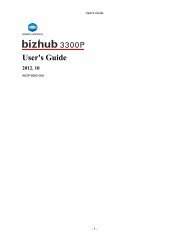
![User's Guide Print Operations [IC-208] - Konica Minolta](https://img.yumpu.com/17742233/1/184x260/users-guide-print-operations-ic-208-konica-minolta.jpg?quality=85)
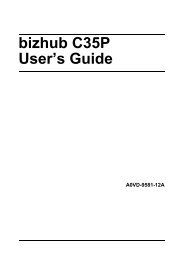
![User's Guide [Network Administrator] - Konica Minolta](https://img.yumpu.com/17742212/1/184x260/users-guide-network-administrator-konica-minolta.jpg?quality=85)
![User's Guide [IC-206 Image Controller] - Konica Minolta](https://img.yumpu.com/17742141/1/184x260/users-guide-ic-206-image-controller-konica-minolta.jpg?quality=85)

